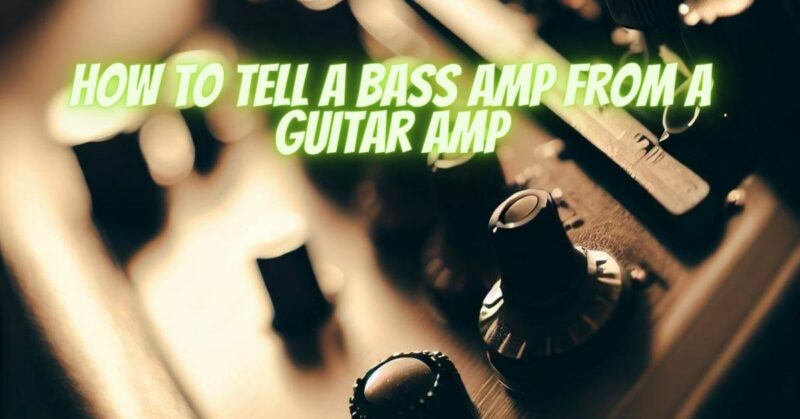Walking into a music store or studio, you might encounter an array of amplifiers, each designed for specific instruments. Being able to differentiate between a bass amp and a guitar amp is essential for musicians, as using the right amplifier enhances the instrument’s sound and preserves its distinct qualities. In this article, we’ll guide you through the key characteristics that help you identify a bass amp from a guitar amp, ensuring that you make informed decisions when amplifying your instruments.
Understanding the Basics
1. Purpose of Amplifiers:
Amplifiers are designed to amplify the sound produced by musical instruments, enhancing their volume and tonal characteristics. Bass amps and guitar amps are tailored to the unique sonic qualities of each instrument.
2. Sonic Range:
Bass amps are engineered to emphasize the low frequencies produced by bass guitars, while guitar amps highlight the midrange and high frequencies produced by electric guitars.
Key Characteristics of Bass Amps
1. Speaker Size:
Bass amps typically feature larger speakers (10 inches or more) to effectively reproduce the deep frequencies produced by bass guitars.
2. Low-End Emphasis:
Bass amps prioritize the reproduction of low frequencies, delivering a deep and powerful sound that forms the rhythmic foundation of a band’s arrangement.
3. Power Handling:
Due to the nature of bass frequencies, bass amps often have higher wattage and power handling capabilities to prevent distortion and ensure clarity.
4. Less Midrange Distortion:
Bass amps are designed to minimize midrange distortion, as bass guitars require clean and deep tones.
Key Characteristics of Guitar Amps
1. Speaker Size:
Guitar amps typically feature smaller speakers (usually 8 or 12 inches) to highlight the midrange and high frequencies of electric guitars.
2. Midrange Emphasis:
Guitar amps accentuate the midrange frequencies, allowing electric guitars to cut through the mix with clarity and sustain.
3. Distortion and Overdrive:
Guitar amps often include built-in distortion and overdrive features, enhancing the harmonically rich and sustained tones required for guitar solos and melodies.
4. Variety of Tones:
Guitar amps offer a wide range of tones and effects to cater to different playing styles, including clean, crunch, and high-gain settings.
Visual and Technical Differences
1. Control Panel Layout:
Observe the control panel layout. Bass amps might have simpler controls focused on EQ adjustments and volume, while guitar amps often include additional features like gain, reverb, and effects loops.
2. Input Jacks:
Check the input jacks. Bass amps typically have a single input, while guitar amps might have multiple inputs to accommodate passive and active pickups.
3. Impedance Matching:
Consider impedance matching. Bass amps often have higher impedance ratings to handle the lower frequencies produced by bass guitars.
Understanding how to tell a bass amp from a guitar amp is crucial for musicians seeking optimal sound quality and performance. By focusing on key characteristics like speaker size, sonic emphasis, power handling, and control panel features, you can easily identify whether an amplifier is tailored for bass or guitar. By selecting the right amplifier for your instrument, you ensure that the unique tonal qualities and sonic characteristics of your bass or guitar are faithfully represented, enhancing your musical experience and allowing your instrument to shine in any setting.


